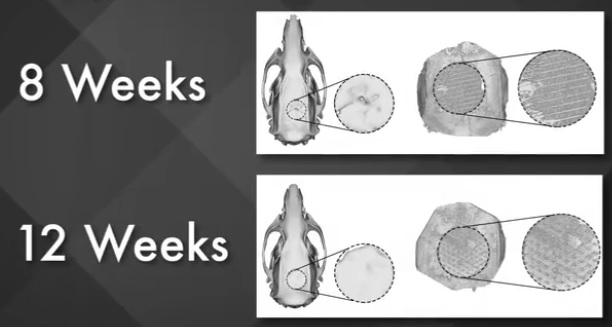Researchers from Northwestern University, and the University of Illinois at Chicago (UIC) have used 3D printed hyperelastic bone to regenerate skull defects in rats. The results could eventually lead to the development of a much needed cost-effective solution for craniofacial bone grafts.
Though further experimentation is required, the researchers state, “Our study underscores the promising translational potential of this novel strategy for tissue engineering applications, particularly bone regeneration.”

3D printing for bone regeneration
Hyperelastic bone is made using hydroxyapatite (the main mineral in bone) and polyglycolic acid. As the name suggests, this mixture gives the material high elasticity, as well as biocompatibility, making it an excellent, potential replacement for natural bone.
In craniofacial reconstruction in particular, the Northwestern/UIC team recognized that irregular defects could benefit from the malleability and customization offered by 3D printed hypereleastic implants. To investigate, in the most recent study the team used the material to create synthetic scaffolds with intricate latticework, mimicking the structure of natural bone.
These scaffolds were then implanted in 8mm calvarial or skullcap defects in rats, and the capacity for bone regeneration was studied.

A malleable bone substitute
Following microscopic examination, it was found that the 3D printed hyperelastic bone scaffold was 74% percent effective after 8 weeks and 65% after 12 weeks. Over the period, the implants were gradually surrounded by fibrous tissue, then by new bone cells, which would eventually grow into new bone. Overall, the 3D printed implants produced 10% more bone volume than standard bone grafts.
The team concluded that the 3D printed alternative could be clinically translated to treat human cranial defects. It was also suggested that hyperelastic bone scaffolds are malleable enough to be press-fit or cut into shape during surgery.
Full results of the study were published in Plastic and Reconstructive Surgery journal. “Three-Dimensionally Printed Hyperelastic Bone Scaffolds Accelerate Bone Regeneration in Critical-Size Calvarial Bone Defects” is co-authored by Yu-Hui Huang, Adam Jakus, Sumanas Jordan, Zari Dumanian, Kelly Parker, Linping Zhao, Pravin Patel and Ramille Shah.
Follow the latest medical developments in 3D printing as they happen. Subscribe to the 3D Printing Industry newsletter, follow us on Twitter and like us on Facebook.
Our 3D Printing Jobs service is now live. Post a job or advance your career in 3D printing now.
Featured image shows the 3D printed Hyperelastic Bone scaffold. Image via UIC/Northwestern University.


